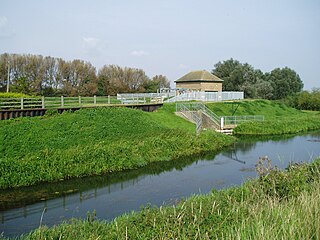
The River Glen is a river in Lincolnshire, England with a short stretch passing through Rutland near Essendine.

The Great Northern Railway (GNR) was a British railway company incorporated in 1846 with the object of building a line from London to York. It quickly saw that seizing control of territory was key to development, and it acquired, or took leases of, many local railways, whether actually built or not. In doing so it overextended itself financially.

Spalding /ˈspɒldɪŋ / is a market town with a population of 28,722 at the 2011 census, on the River Welland in the South Holland district of Lincolnshire, England. Little London is a hamlet directly south of Spalding on the B1172, whilst Pinchbeck, a village to the north, is part of the built-up area.

The Midland and Great Northern Joint Railway (M&GNJR) was a railway network in England, in the area connecting southern Lincolnshire, the Isle of Ely and north Norfolk. It developed from several local independent concerns and was incorporated in 1893. It was jointly owned by the Midland Railway and the Great Northern Railway, and those companies had long sponsored and operated the predecessor companies.

Peterborough railway station serves the city of Peterborough, Cambridgeshire, England. It is 76 miles 29 chains (122.9 km) down the East Coast Main Line from London King's Cross. The station is a major interchange serving both the north-south ECML, as well as long-distance and local east–west services. The station is managed by London North Eastern Railway. Ticket gates came into use at the station in 2012.
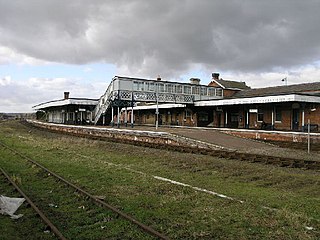
Sleaford railway station serves the town of Sleaford in Lincolnshire, England. It lies on the Peterborough–Lincoln line. The station is 21.25 miles (34 km) south of Lincoln Central.

Spalding railway station serves the town of Spalding, Lincolnshire, England. It lies on the Peterborough–Lincoln line.

South Lynn railway station was a station located in King's Lynn, Norfolk, on the Midland and Great Northern Joint Railway.
The Great Northern and Great Eastern Joint Railway, colloquially referred to as "the Joint Line" was a railway line connecting Doncaster and Lincoln with March and Huntingdon in the eastern counties of England. It was owned jointly by the Great Northern Railway and the Great Eastern Railway. It was formed by transferring certain route sections from the parent companies, and by the construction of a new route between Spalding and Lincoln, and a number of short spurs and connections. It was controlled by a Joint Committee, and the owning companies operated their own trains with their own rolling stock. The Joint Line amounted to nearly 123 miles of route.
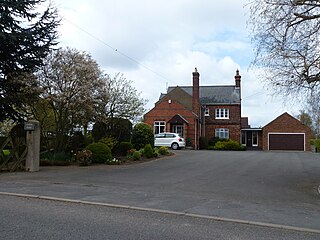
Moulton (Lincolnshire) railway station was a station in Moulton, Lincolnshire. Built by the Norwich and Spalding Railway,, opened on 15 November 1858, that closed to passengers on 2 March 1959.

Weston railway station was a station in Weston, Lincolnshire on the Midland and Great Northern Joint Railway, Built by the Norwich and Spalding Railway and opened on 15 November 1858. It was on the main line between the Midlands and the Norfolk Coast, a route commonly used by holidaymakers in the summer months. It closed to passengers on 2 March 1959. The line divided west of here, some trains running in to terminate at Spalding and others carrying on west into the Midlands.
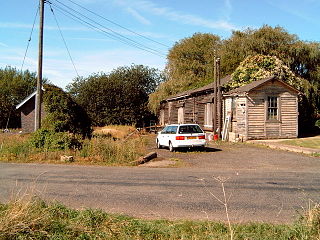
North Drove railway station was a station serving Pode Hole in Lincolnshire, England. It was on the route of the Spalding and Bourne Railway, later part of the Midland and Great Northern Joint Railway.

Eye Green railway station was a station in Eye, Cambridgeshire, on the Midland and Great Northern Joint Railway line between Peterborough and Wisbech. The station was opened by the Peterborough, Wisbech and Sutton Bridge Railway (PW&SBR) on 1 August 1866 and was originally named "Eye"; it was renamed "Eye Green" on 1 October 1875. The PW&SBR became part of the Midland and Great Northern Joint Railway. It later came under the control of British Railways and was closed on 2 December 1957. The station's name as given in some timetables "Eye Green for Crowland" was misleading, since a passenger would have a three-mile walk to Crowland.

Murrow West railway station was a station on the Great Northern and Great Eastern Joint Railway in Murrow, Cambridgeshire between Spalding, England, and March. It opened in 1867 and was closed by the British Transport Commission in July 1953 due to low usage. The line itself survived until closure by British Rail in November 1982. The station has mostly been demolished although the signal box still survives, having been converted into a private dwelling after the closure of the line and subsequent removal of the track.

Twenty railway station served the village of Twenty, Lincolnshire. It was on the route of the Spalding and Bourne Railway, later part of the Midland and Eastern Railway and then part of the Midland and Great Northern Joint Railway main line between the Midlands and the Norfolk Coast.

Bourne was a railway station serving the town of Bourne in Lincolnshire which opened in 1860 and closed to passengers in 1959.

Saxby railway station was a station serving the villages of Saxby and Freeby, Leicestershire. It was located between the two villages.

Southrey railway station is a former station in Southrey, Lincolnshire.
The Stamford and Essendine Railway was built to connect Stamford, Lincolnshire, in England, to the nearby Great Northern Railway. It was a short line, and it opened in 1856. It was not commercially successful, and the directors sought a means of connecting Stamford directly to Peterborough. This was the Sibson Extension, opened from Stamford to Wansford in 1867, but the junction there did not facilitate through running to Peterborough, and the Sibson Extension was even less successful than the first line. It was closed in 1929.
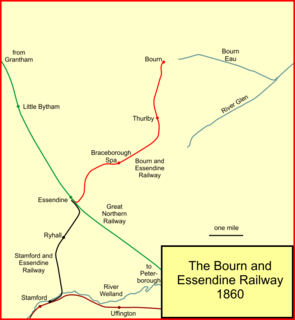
The Bourn and Essendine Railway was promoted locally to give the small town of Bourn a railway connection to London over the nearby Great Northern Railway. The line was opened in 1860; it was a single line of seven miles length, and its route was in Lincolnshire and Rutland, England. There was talk of forming a through line with the Stamford and Essendine Railway, which was also at Essendine station, but on the other side of the main line, and this direct connection never took place. The Bourn and Essendine Railway was the first railway to reach Bourn, which later became a local focal point for single-track railways. The company never made money and sold itself to the GNR in 1864.


















